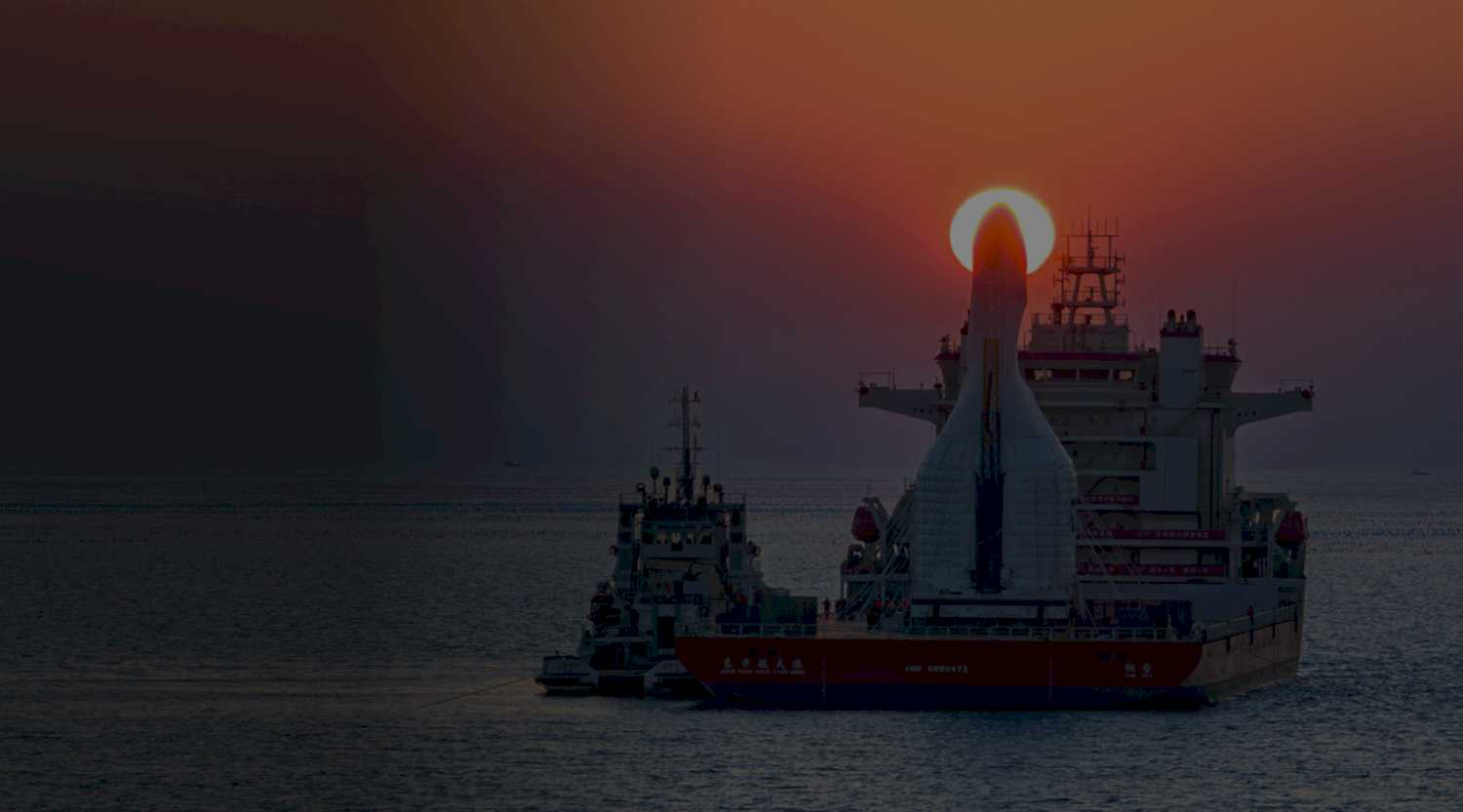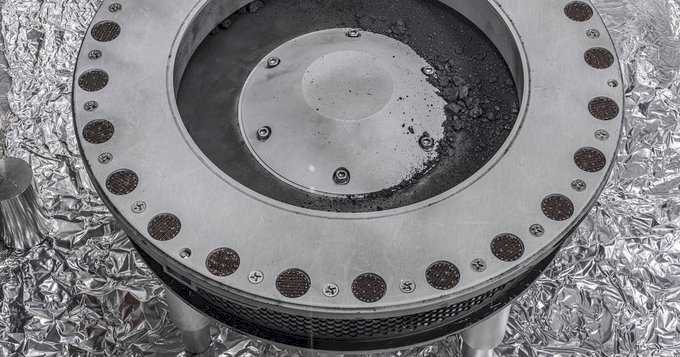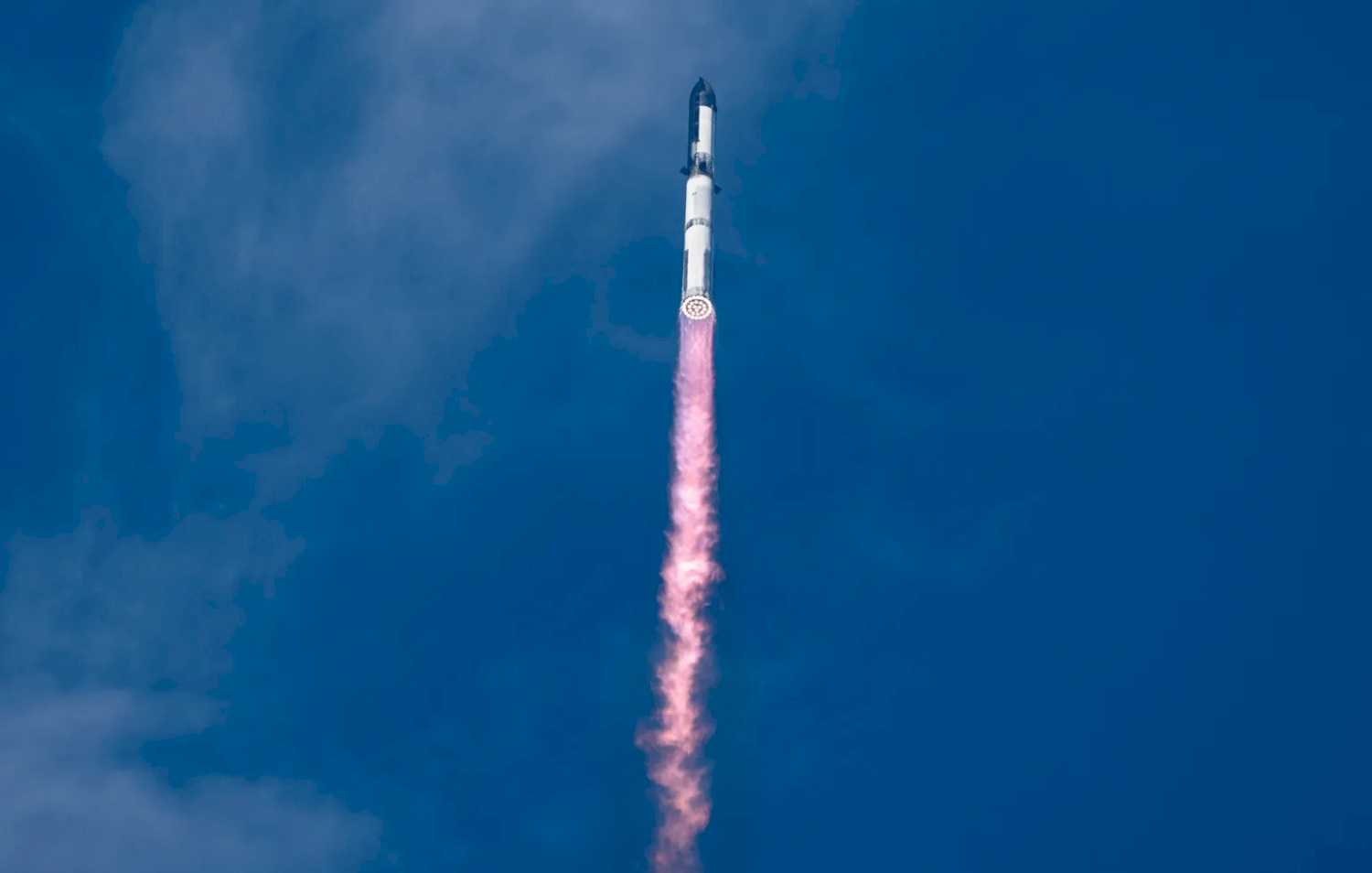MANCHESTER, United Kingdom — Chinese commercial rocket company #Orienspace has raised tens of millions of dollars in Series B+ financing as it moves towards a key test flight. #spacenews

MANCHESTER, United Kingdom — Chinese commercial rocket company #Orienspace has raised tens of millions of dollars in Series B+ financing as it moves towards a key test flight. #spacenews

View 408 times
#Spacedust from asteroid Bennu provides glimpse into celestial past. MONTREAL — #New research on a sample collected from the asteroid Bennu — a small portion of which should arrive in Canada soon — is offering a glimpse into how it came to be.
Studies published in Nature Astronomy and Nature Geoscience last week offer some insight into the granules that were collected and brought to Earth in September 2023 as part of NASA-led OSIRIS-REx mission.
The three studies, which include Canadian scholars, found that Bennu is a near-Earth asteroid, but its composition suggests the parent asteroid it split from contains materials from throughout the solar system.
“What they’ve done is they’ve looked at the origin and the formation and evolution of the Bennu sample to understand its history,” said Dr. Patrick Hill, program scientist at the Canadian Space Agency.
The new research comes as Canada is preparing to receive its own portion for scientific research. Due to its contribution to the mission to retrieve the sample, the Canadian Space Agency will get a cut of the celestial bounty, but no earlier than 2026.
“The CSA is building its capacity to curate its first sample collected in space,” Hill said. Construction of a clean room south of Montreal began in January 2025. The sample would arrive in a carefully co-ordinated transfer with NASA, Hill said.
When it does, it would make Canada the fifth country in the world to curate samples that have been collected in space.
Canada’s will host about four per cent of the total 122 grams of dust and pebbles — just under five grams.
“This area is quite niche because of the astral materials and there’s a lot of requirements that we have to make sure are implemented to ensure that we are not contaminating the sample,” Hill said, which means protecting it from water, organic molecules or plastics.
“The goal of these missions is not to modify the material while it’s here on Earth,” Hill said.
The NASA-led mission launched OSIRIS-REx into space in 2016 to collect from the surface of an asteroid material that scientists hope will offer them insight into the formation of the solar system.
The spacecraft began orbiting the asteroid — called Bennu — in 2018 and grabbed a sample in 2020.
It began a return to Earth in 2021, and a capsule with the rocks and space dust landed in the Utah desert finally arriving in September 2023.
Canada’s contribution to the mission was a laster altimeter tool, known as OLA, which measures altitude and distance. As a result, Bennu was heavily surveyed, with billions of measurements of the asteroid over two years.
The tool helped pinpoint the best place to get a sample, with the craft landing briefly to collect the material.
The most recent studies found that Bennu was formed from a larger parent asteroid destroyed by a collision in the asteroid belt between the orbits of Mars and Jupiter. That parent asteroid formed in the outer solar system with material from a variety of locations including beyond our own solar system.
It was formed from dust from our solar system and organic matter from interstellar space. The analysis of the sample thus far have shown the presence of stardust grains that have compositions that predate the solar system, Hill said.
“We have a lot of meteorites that provide a lot of information about this sort of area of research, but these missions are great because you go and get the sample and you bring it back,” Hill said.
“So it’s not altered by travelling through the atmosphere and modification on the Earth’s surface, so it allows us to really look at the pristine material in detail.”
Another study found that the asteroid was dramatically transformed over time by interactions with water and exposure to the harsh space environment.
This report by The Canadian Press was first published Aug. 31, 2025.
Sidhartha Banerjee, The Canadian Press

View 420 times
#BEIJING, August 26. During a recent working visit to China from August 21 to 26, Science and Higher Education Minister Valery Falkov shared Russia’s aspirations for enhanced scientific collaboration, highlighting the potential for a Chinese experimental station at the Siberian Ring Photon Source (SKIF Collective Use Center). Speaking to TASS, Falkov emphasized the mutual benefits of such partnerships, noting that they enrich the scientific capabilities of both nations.
"We recognize and support the keen interest of our Chinese partners in collaborating on Russia’s megascience infrastructure," Falkov stated. "Such cooperation not only advances our scientific objectives but also fosters shared progress. We anticipate that a Chinese experimental station could be integrated into the SKIF Collective Use Center, which is currently under construction in Koltsovo. Additionally, we have extended invitations for our partners to participate in the International Center for Neutron Research, based on the PIK high-flux reactor in the Leningrad Region, as well as in initiatives to develop a network of modern synchrotron radiation sources, overseen by the Kurchatov Institute National Research Center."
Falkov underscored the importance of expanding China’s role in building international scientific information repositories. "In today’s landscape of scientific discovery, the volume and integration of data directly influence our ability to make new breakthroughs. Enhancing China’s participation in these data-sharing efforts is therefore highly promising."
He also stressed the necessity of coordinated international efforts in big science projects. "Large-scale collaborations are vital for advancing global scientific frontiers. During our visit, we toured several Chinese megascience facilities, including the EAST tokamak. The dedication of Chinese partners to developing cutting-edge scientific technologies, especially in controlled thermonuclear fusion, is truly commendable. The Chinese fusion program received a significant boost when the Kurchatov Institute transferred the Tokamak T-7 facility to China. Today, China stands at the forefront of this field, and I am confident that continued joint efforts will benefit not only our nations but humanity as a whole."
Recalling recent developments, Falkov highlighted a quadripartite protocol signed in May 2023 between Russian and Chinese authorities, the Chinese Academy of Sciences, and the Joint Institute for Nuclear Research. "This agreement outlines priority areas such as joint experiments in heavy ion physics, neutron research, and theoretical physics, alongside work on medical accelerators within the BESIII and JUNO projects, as well as research utilizing the NICA collider in Dubna. Importantly, these agreements are already yielding tangible results - eight scientific projects have been selected and are underway.".
View 386 times
SpaceX postpones Starship test flight over ground system issue.
Elon Musk’s SpaceX on Sunday called off the launch of Starship’s tenth mission from Texas over an issue at its launch site, delaying an attempt to achieve several long-sought development milestones missed due to past tests ending in early failures.
The 232-foot(70.7-metre)-tall Super Heavy booster and its 171-foot(52-metre)-tall Starship upper half sat stacked on a launch mount at SpaceX’s Starbase rocket facilities as it was being filled with propellant ahead of a liftoff time of 7:35 p.m. ET (2335 GMT).
But roughly 30 minutes from liftoff, SpaceX said on X it was “standing down from today’s tenth flight of Starship to allow time to troubleshoot an issue with ground systems.”
Musk had been poised to provide an update on Starship’s development progress prior to the rocket’s launch on Sunday, but a placeholder live stream indicated it had been canceled.
SpaceX did not say when it would make another launch attempt. Similar scrubs in the past have been resolved in a matter of days.
Development of SpaceX’s next-generation rocket, the center of the company’s powerful launch business future and Musk’s Mars ambitions, has faced repeated hiccups this year as NASA hopes to use the rocket as soon as 2027 for its first crewed moon landing since the Apollo program.
This year, two Starship testing failures early in flight, another failure in space on its ninth flight, and a massive test stand explosion in June that sent debris flying into nearby Mexican territory have tested SpaceX’s test-to-failure development approach. Still, the company has continued to swiftly produce new Starships for test flights at its sprawling Starbase production facilities.
Those setbacks underscore the technical complexities of Starship’s latest iteration, packed with far more capabilities such as increased thrust, a potentially more resilient heat shield and stronger steering flaps crucial to nailing its atmospheric reentry - key traits for Starship’s rapid reusability that Musk has long pushed for.
The stacked system had been expected to blast off from Texas around sunset on Sunday before its Starship upper stage separated from the Super Heavy booster dozens of miles in altitude. Super Heavy, which has returned for a landing at its launch pad in giant mechanical arms in past tests, would have instead targeted the Gulf of Mexico for a soft water landing in order to test a backup engine configuration.
Starship was to briefly ignite its own engines to blast further into space, where it would have attempted to release its first batch of mock Starlink satellites and reignite an engine while on a suborbital path around the planet.
After that phase, the ship targets an atmospheric reentry over the Indian Ocean, a crucial flight phase that tests a variety of prototypical heat shield tiles and engine flaps designed to endure a barrage of blazing heat that has largely shredded the rocket’s exterior during past flights.
“Starship’s reentry profile is designed to intentionally stress the structural limits of the upper stage’s rear flaps while at the point of maximum entry dynamic pressure,” SpaceX said on its website.
(Reporting by Joey Roulette; Editing by Richard Chang, Diane Craft and Sandra Maler)

View 385 times
An ‘existential gamble’: Why some experts are worried as SpaceX gears up for next Starship test.
The most powerful rocket system ever constructed is headed for its next test — using a version of the vehicle that has been at the center of a series of explosive missteps and failures.
SpaceX said it is aiming to launch its Starship megarocket on an hour-long test flight as soon as 7:30 p.m. ET Sunday, though the liftoff time is subject to change. A webcast of the event is expected to begin about 30 minutes earlier, according to the company.
The uncrewed Starship prototype will follow a similar flight plan to the last three missions and aim to complete test objectives left untried during those tests, all of which ended prematurely. SpaceX debuted the current generation of Starship vehicles in January, following a clean run of test missions with a slightly scaled-down version of the rocket in 2024.
But since that debut, the vehicle has twice exploded over populated islands east of Florida, creating debris that hit roadways in Turks and Caicos and washed up onto the shores of Bahamian islands. The spacecraft also spun out of control as it headed toward its landing site in the Indian Ocean on its last test flight in May.
Then, in June, a Starship spacecraft that had been strapped to an engine testing stand at the company’s launch and development facilities in South Texas abruptly exploded — spewing shrapnel and causing damage to SpaceX infrastructure.
These setbacks roused long-standing SpaceX critics and attracted new ones, including the Mexican government, which has threatened legal action against the company over reported debris on and around its shores. The UK government also said in a statement Thursday that it’s been “working closely with U.S. Government partners to protect the safety” of its overseas territories, including Turks and Caicos.
The string of mishaps this year has also raised concerns among spaceflight experts and stakeholders who have emphasized that the United States has a lot riding on Starship’s eventual success, including its plans to return humans to the moon as soon as 2027.
And that success is not guaranteed.
“It’s very, very difficult to predict how this is going to end up,” said Garrett Reisman, a former NASA astronaut and SpaceX consultant who is a professor of astronautical engineering at the University of Southern California.
“I think it could end up never working, or it could end up revolutionizing our entire future of activities in space — and geopolitics,” he added, referring to the U.S. goal of displaying technical superiority to China in a new space race.
Why SpaceX is allowed to fly again
SpaceX said it implemented changes to the Starship system slated to fly this weekend in response to the last in-flight failure in May.
Those alterations include adjustments to a component called a fuel diffuser, which the company believes malfunctioned during the last flight, causing higher-than-expected pressure to build up in Starship’s nose cone. It is likely what caused the vehicle to spiral out of control, according to a technical overview SpaceX published last week.
Despite the series of recent problems, the Federal Aviation Administration — which licenses commercial rocket launches — said last week it had closed its investigation into SpaceX’s latest mishap and approved the company’s plans to fly Sunday’s mission.
Under current laws and regulations, the FAA is tasked solely with ensuring that commercial rocket companies do not pose a risk to public property or bystanders’ safety.
“There are no reports of public injury or damage to public property. The FAA oversaw and accepted the findings of the SpaceX-led investigation,” the agency said in an August 15 statement. “SpaceX identified corrective actions to prevent a reoccurrence of the event.”
A long road ahead
In its update, SpaceX also made clear that the version of Starship that has experienced so many issues will soon be retired.
“Two flights remain with the current generation, each with test objectives designed to expand the envelope on vehicle capabilities,” according to a company blog post.
SpaceX CEO Elon Musk has already been teasing plans for larger, more ambitious iterations of the vehicle that would stretch even taller and carry more propellant.
Now it appears clear that SpaceX will pursue that scaled-up version of Starship — which is already more than twice as powerful as the NASA rockets that powered the Apollo moon landings — whether or not the current line of Starship prototypes ever pulls off a successful test flight.
“It’s very possible that a bigger upgrade might solve the current problem,” Reisman said. “It also could introduce new problems — you never know.”
Notably, the U.S. government has taken several steps that could aide SpaceX in its efforts to expedite Starship testing.
In May, the FAA approved the company’s plans to launch Starship as many as 25 times per year from Texas, up from the five it had been previously authorized to conduct.
And earlier this month, U.S. President Donald Trump — despite a public and vitriolic falling out with Musk in June — issued an executive order that appears designed to scale back roadblocks and regulatory oversight for private-sector rocket operations, including environmental reviews.
Meanwhile, the stakes appear to be growing with each Starship test flight, as SpaceX is racing against the clock.
Not only does Musk want to send one of the vehicles on an uncrewed flight to Mars when the next opportunity arises in 2026, but NASA also plans to send its astronauts to the lunar surface aboard one of the vehicles as soon as mid-2027 as part of a $2.9 billion contract.
“We made this bet” on Starship, said Janet Petro, who served as acting NASA administrator until July. “They have had a rough year, but SpaceX is a pretty intense and motivated company.”
Petro added she had “full confidence” that SpaceX will refine Starship’s design and get the vehicle working.
Reisman, the former SpaceX adviser, said he is also hopeful but less certain.
“SpaceX has made an existential gamble on Starship,” Reisman said, adding that he is concerned about the rate of progress SpaceX has been making with Starship. “They’re pouring a tremendous amount of money and resources into its development … but at some point, the laws of financial physics still apply.”
What SpaceX hopes to achieve with Flight 10
If all goes according to plan with Starship’s next flight, referred to as Flight 10, the 400-foot-tall Starship launch system will take off from SpaceX’s facilities in South Texas and soar out over the waters off the coast.
The bottom portion of the rocket system that gives the initial burst of power at liftoff, called Super Heavy, will attempt to make a controlled splashdown off the Texas coast, according to SpaceX.
For this mission, the company will not attempt to repeat its dramatic Super Heavy “chopsticks” landing in which the rocket booster steers itself back into the arms of the tower from which it launched. SpaceX said it will instead put the booster through a series of tests designed to push the vehicle to its limits “to gather real-world performance data” that could mimic a future mission that does not go as planned.
Meanwhile, the upper Starship spacecraft, which is designed to one day carry cargo or convoys of astronauts but will haul only dummy satellites for this mission, will continue flying through space.
During the flight, Starship will attempt to deploy the eight satellite “simulators” as well as relight one of the spacecraft’s rocket engines in space. SpaceX has failed to hit both of those milestones in its last three test missions.
Even if this V2 Starship prototype meets a similarly ill fate, SpaceX is likely once again to frame the test flight as a success.
The company employs an engineering philosophy called “rapid iterative development,” which emphasizes a pursuit of launching relatively cheap prototypes on frequent test missions over extensive ground testing or other less risky simulations.
Because of its unique development approach, SpaceX has been known to embrace fiery mishaps. The company has said that even failed test flights help engineers improve Starship’s design — quicker than if SpaceX employed alternative engineering approaches.
“Every lesson learned, through both flight and ground testing, continues to feed directly into designs for the next generation of Starship and Super Heavy,” SpaceX’s August 15 statement reads. “Two flights remain with the current generation, each with test objectives designed to expand the envelope on vehicle capabilities as we iterate towards fully and rapidly reusable, reliable rockets.”
SpaceX’s development approach, while often seen as risky and brazen, has served the company well in the past.
Rarely has one of the company’s rockets malfunctioned once it leaves the development stage and becomes operational. The company’s human spaceflight track record, using Falcon 9 rockets, has been spotless.
And if Starship does eventually work, Reisman said, it won’t only be SpaceX — or even NASA — that benefits.
“The entire space industry is hoping and betting on Starship working, because if it achieves its promise, it’ll also be a revolution in affordability,” Reisman said. “I think there’s causes for optimism and pessimism — and I think it’s very, very difficult to predict how this is going to end up.”
By Jackie Wattles, CNN

View 380 times
#Hurricane Erin downgraded to Category 3 as tropical storm warning issued for Turks and Caicos.
Hurricane Erin weakened to a Category 3 hurricane Sunday as its outer bands continued to lash the Virgin Islands and Puerto Rico with heavy rains and tropical-storm force winds.
While Erin’s maximum winds diminished, the storm’s overall size grew and forecasters issued tropical storm warnings for the Turks and Caicos Islands and a watch for the southeast Bahamas.
The storm wasn’t expected to directly impact the U.S. East Coast, but by doubling or tripling in size it could bring rip currents all along the Southeast coast. Gusty winds and flooding tides could wash out parts of the highway that connects the North Carolina Outer Banks by midweek, the National Weather Service said.
Bermuda could have similar conditions as Erin is forecast to turn to the north and then northeast, forecasters said.
Erin, the first Atlantic hurricane of 2025, reached Category 5 status Saturday with maximum winds of 160 mph (260 km/h) before weakening.
The storm’s maximum sustained winds were 125 mph (205 km/h) late Sunday morning, according to the National Hurricane Center in Miami.
The winds decreased as the storm went through internal changes. Erin is expected to remain powerful for the next several days, forecasters said.

View 337 times
PARK CITY, Utah — SpaceX will perform its next Starship/Super Heavy test flight Aug. 24 after completing an investigation into the failure of the previous mission and getting approval from the Federal Aviation Administration.

View 338 times
#MOSCOW, August 15. An asteroid known as 2025 PM with a diameter of about 50 meters will pass Earth on August 17 at a distance approximately equivalent to the distance between our planet and the Moon, the laboratory of solar astronomy of the Space Research Institute (IKI) of the Russian Academy of Sciences told TASS.
"On August 17, asteroid 2025 PM will pass by at a distance of approximately one diameter of the lunar orbit from Earth. This is one of the closest approaches of an object of such a size in recent time so it has been included in the potentially hazardous list," the laboratory said.
2025 PM is one of the largest asteroids recently getting closer than one million kilometers near Earth. The passage of a larger object at a comparable distance is expected only once this year, at the end of September.
The asteroid was detected on August 1. It does not display any cometary properties, and, according to preliminary data, is a stone rock without any traces of volatile substances. It is an Apollo-categorized asteroid from a group of near-Earth asteroids with their orbits intersecting Earth’s orbit from the outside. 2025 PM’s orbital period is slightly over two years.
The asteroid will come the closest to Earth on August 17 at 12:03 p.m. Moscow time (9:03 a.m. GMT). According to calculations, despite being within Earth’s gravitational pull, the probability of its "capture" is very low and may occur only in the event of an unforeseen collision with another celestial body.
The laboratory reiterated that the most well-known fall to Earth of a meteorite of a comparable size occurred about 50,000 years ago, creating the Barringer Crater in Arizona in the US.
View 351 times
Could the U.S. actually build a nuclear reactor on the moon? Here’s what an expert says:
As #NASA eyes a return to the moon, the agency has set an ambitious goal: deploy a nuclear reactor on the lunar surface by 2030 to provide consistent energy for future missions.
But how feasible is this idea?
According to Lionel Wilson, professor emeritus of Earth and Planetary Sciences at Lancaster University, powering a moon base is one of the most significant challenges facing long-term lunar exploration.
“The moon has no atmosphere, no wind and no renewable resources like coal or forests,” Wilson told CTV’s Your Morning Thursday. “So solar power is the obvious (source).”
Wilson explained that the moon rotates slowly - taking 28 days to complete one rotation - experiencing 14 days of sunlight followed by 14 days of darkness. He says that means bases would need extensive battery systems to store power or a reliable alternative.
According to Wilson, a system that provides constant power, like a radioisotope generator, helps reduce reliance on solar energy. It keeps producing electricity around the clock, so even if a solar setup fails, there’s a reliable backup.
Acting NASA administrator Sean Duffy has directed the agency to fast track plans to put a nuclear reactor on the moon, a moved aimed at staying ahead of China and Russia, which have jointly announced efforts to build a similar system by the mid-2030s.
NASA has previously collaborated with the U.S. Department of Energy on fission surface power projects, which were capable of delivering 40 kilowatts - enough to power 30 homes for 10 years.
The type of system NASA has used in deep-space probes, where solar power is too weak, relies on small amounts of plutonium, Wilson said. But for the 100 kilowatts of power NASA hopes to generate on the moon, Wilson estimates much more would be needed.
“About 200 kilograms of plutonium - that’s roughly a fifth of a ton,” he said. “That’s what it would take using the same design currently powering spacecraft.”
Still Wilson believes producing such a reactor in time is technically possible. The bigger question is whether humans will be back on the moon by then. There’s no point in getting the power source to the moon if you’re not getting the people there,” he said.

View 355 times
Space news on Umojja.com